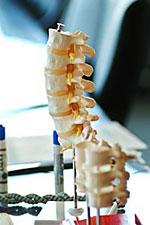 Osteoporosis is a silent disease with no outward symptoms until a bone breaks. The word osteoporosis means “porous bones,” which are bones that have weakened structure and have lost some of their strength, or bone density. When bones lose density, they are weaker and more likely to break or fracture. Maintaining good bone density is the key to preventing or treating osteoporosis.
Osteoporosis is a silent disease with no outward symptoms until a bone breaks. The word osteoporosis means “porous bones,” which are bones that have weakened structure and have lost some of their strength, or bone density. When bones lose density, they are weaker and more likely to break or fracture. Maintaining good bone density is the key to preventing or treating osteoporosis.
Because bones are actually alive, your bone structure and density are constantly in a state of change. Throughout your life, special cells are hard at work constantly building up and breaking down bones. The cells responsible for building, called osteoblasts, are in high gear until around age 30. As you age, the cells in charge of breaking down bones, known as osteoclasts, naturally speed up, causing bones to lose density. But even then the osteoblasts build more bone, just at a slower pace. For people with osteoporosis, the osteoclasts are very active, breaking down bone much faster than the osteoblasts can build it.
